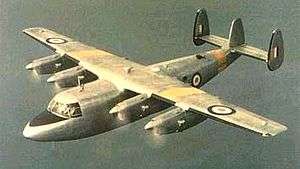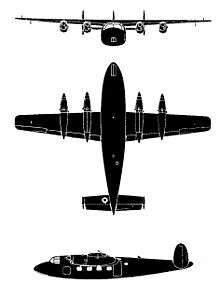Handley Page Marathon
| Marathon | |
|---|---|
 | |
| RAF Marathon 1953–1958 | |
| Role | Light transport |
| Manufacturer | Handley Page |
| First flight | 19 May 1946 |
| Introduction | 1951 |
| Retired | 1960 |
| Primary users | Royal Air Force West African Airways Corporation |
| Produced | 1946–1951 |
| Number built | 43 |
|
| |
The Handley Page (Reading) H.P.R.1 Marathon was a British civil 20-passenger light transport produced by Handley Page (Reading) Limited of Woodley Aerodrome, Reading, England.
Design and development
The Marathon originated as a design to meet the requirements of the Brabazon Committee. It was designed by Miles Aircraft Limited as a high-wing cantilever monoplane with four engines and all-metal construction. It was capable of carrying two crew and up to 20 passengers. The aircraft was designated the Miles M.60 Marathon with the first of three prototypes (registered U-10) flying on 19 May 1946. A total of 25 aircraft were ordered by the Ministry of Supply and 25 by British European Airways, but Miles had financial problems and needed orders for over 100, not helped when the prototype aircraft crashed and the power shortages led to the loss of components already produced. When the Miles company went bankrupt, Handley Page bought the assets, including the factory at Woodley near Reading, Berkshire and design rights to the Marathon.
The new company, known as Handley Page (Reading) Limited, started producing the Marathon with 40 aircraft built over the next three years with the new designation Handley Page (Reading) H.P.R.1 Marathon 1. A twin-engine prototype turboprop-powered version (using the Armstrong Siddeley Mamba) was flown in 1949.
Operational history
The first production Marathon 1 aircraft (registered G-ALUB) left Woodley on 14 January 1950 for a sales tour of Australia and New Zealand. The aircraft was painted in BEA markings as "Rob Roy" in September 1951 and was demonstrated to the airline at Heathrow. During acceptance tests for British European Airways it was decided that the Marathon was not suitable to replace the de Havilland Dragon Rapide and the order was reduced to seven aircraft, none of which were accepted by BEA.[1]
Six Marathons were delivered to the West African Airways Corporation in late 1952 for operation in and between the British colonies in that region. They were replaced in 1954 by de Havilland Herons. The last three production aircraft were given increased tankage and sold to Union of Burma Airways which operated them in the region for several years.[2]

Most of the returned and unsold aircraft were then diverted for use by the Royal Air Force as navigation trainers with the designation Marathon T.11. After internal modifications, most of the 28 aircraft taken on charge from early 1953 were used by No. 2 Air Navigation School at RAF Thorney Island, Hants. A total of 16 aircraft were transferred to RAF Topcliffe, Yorks in June 1958 when No.1 Air Navigation School relocated there. By February 1969, only eight were airworthy. Apart from mechanical unreliability, the main problem was tail-heavy trim, an absolute ceiling of 9,500 feet, and a rate of climb of only 300 ft a minute. The navigational trainers were retired in April 1959 and most were quickly scrapped.[3] A few Marathons were operated by other UK military users including the Royal Aircraft Establishment.

Three Marathons were acquired in 1955 by Derby Aviation, based at Burnaston airport near Derby and predecessor of British Midland Airways. The aircraft were used on scheduled services within the UK and to the Channel Islands until their withdrawal in December 1960. One aircraft was delivered to Jordan in September 1954 for the personal use of King Hussein.
The Mamba-powered Marathon testbed was later fitted with Alvis Leonides Major radial engines and used as a testbed for the projected Herald.
No surviving airframes are known to exist but the upper fuselage section of Marathon M.60 G-AMGW was stored at Woodley, United Kingdom as part of the Miles Collection c. 2000[4]
Variants
- M.60 Marathon
- Miles-built prototypes, two built.
- Miles M.69 Marathon II
- Miles-built version powered by Mamba engines created for British European Airways, only one prototype built.
- Marathon
- Miles M.69 re-engined by Handley Page and used as an engine testbed.
- Marathon I
- Handley Page-built production aircraft, 40 built.
- Marathon T.11
- Military navigation trainer version, 28 modified.
Operators
Civil operators
- British European Airways (not operated on passenger services)[5]
- Derby Aviation[5]
Military and government operators
- West German Government[5]
Accidents and incidents
- 10 May 1948 - Prototype G-AGPD being operated by the Aeroplane and Armament Experimental Establishment crashed near Amesbury, Wiltshire, United Kingdom.[5]
- 4 August 1953 - XY-ACX a Union of Burma Airways Marathon 1A was damaged beyond repair at Myaungmya, Burma.[5]
- 30 September 1954 - XA271 a Royal Air Force Marathon T11 crashed after inflight structural failure near Calne, Wiltshire, United Kingdom.[5][6]
- 9 January 1956 - XA254 a Royal Air Force Marathon T11 was damaged beyond repair when it overran the runway at RAF Topcliffe, the landing gear was retracted in an attempt to stop the aircraft.[6]
- 30 October 1957 - XA256 a Royal Air Force Marathon T11 was damaged beyond repair after the landing gear collapsed in a hangar at RAF Thorney Island.[5][6]
- 16 November 1957 - XA251 a Royal Air Force Marathon T11 was damaged beyond repair.[5]
- 10 December 1957 - XA250 a Royal Air Force Marathon T11 was damaged beyond repair during a landing accident. Landing gear leg jammed and collapsed on landing at RAF Topcliffe, Yorkshire, United Kingdom.[5][6]
- 11 February 1958 - XA268 a Royal Air Force Marathon T11 was damaged beyond repair landing at RAF Topcliffe when the nosewheel became detached.[5][6]
- 22 April 1958 - XA273 a Royal Air Force Marathon T11 was damaged beyond repair after the landing gear collapsed at RAF Topcliffe.[5]
- 5 May 1958 - XA253 a Royal Air Force Marathon T11 was damaged beyond repair when the landing gear was retracted in error for the flaps on the ground at RAF Topcliffe.[5][6]
Specifications (Marathon 1)

Data from British Civil Aircraft since 1919: Volume 2.[7]
General characteristics
- Length: 52 ft 1½ in (15.89 m)
- Wingspan: 65 ft 0 in (19.81 m)
- Height: 14 ft 1 in (4.29 m)
- Wing area: 468 ft² (46.3 m²)
- Empty weight: 11,688 lb (5,313 kg)
- Max. takeoff weight: 18,250 lb (8,295 kg)
- Powerplant: 4 × de Havilland Gipsy Queen 70-3 inline piston, 340 hp (254 kw) each
Performance
- Maximum speed: 233 mph (202 kn, 374 km/h)
- Cruise speed: 201 mph (175 kn, 324 km/h)
- Range: 935 mi (813 nmi, 1505 km)
- Service ceiling: 18,000 ft (5,490 m)
- Rate of climb: 595 ft/min (3.0 m/s)
See also
- Related lists
References
- Notes
- Bibliographys
- Amos, Peter. and Don Lambert Brown. Miles Aircraft Since 1925, Volume 1. London: Putnam Aeronautical, 2000. ISBN 0-85177-787-2.
- Brown, Don Lambert. Miles Aircraft Since 1925. London: Putnam & Company Ltd., 1970. ISBN 0-370-00127-3.
- Eastwood, Tony. and Roach, John Piston Engine Airliner Production List. West Drayton, UK: Aviation Hobby Shop, 1991. ISBN 0-907178-37-5.
- Hailey, James J. (compiler). Royal Air Force Aircraft XA100 to ZA999. Tonbridge, Kent, UK: Air Britain (Historians) Ltd., 2001. ISBN 0-85130-311-0
- The Illustrated Encyclopedia of Aircraft (Part Work 1982-1985). London: Orbis Publishing, 1985.
- Jackson, A.J. British Civil Aircraft since 1919, Volume 2. London: Putnam & Company Ltd., 1973. ISBN 0-370-10010-7.
- Temple, Julian C. Wings Over Woodley: The Story of Miles Aircraft and the Adwest Group. Bourne End, Bucks, UK: Aston Publications, 1987. ISBN 0-946627-12-6.
- Thetford, Owen. Aircraft of the Royal Air Force since 1918. London: Putnam & Company Limited, 1976. ISBN 0-370-10056-5.
External links
| Wikimedia Commons has media related to Handley Page Marathon. |